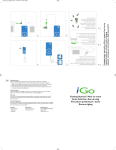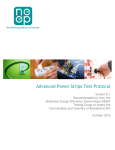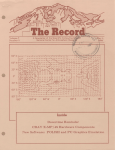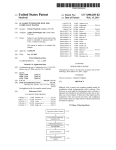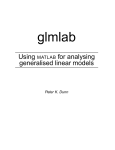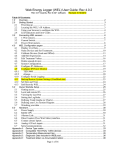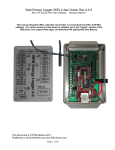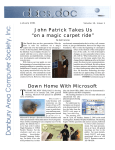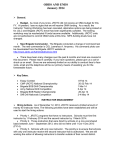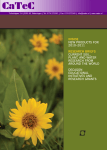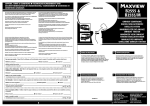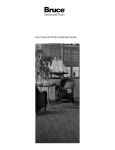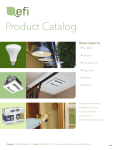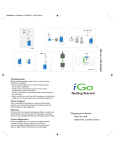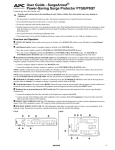Download Results of Laboratory Testing of Advanced Power Strips Introduction
Transcript
Results of Laboratory Testing of Advanced Power Strips Lieko Earle and Bethany Sparn, National Renewable Energy Laboratory ABSTRACT The ever-increasing inventory of miscellaneous electric loads (MELs) in U.S. homes results in wasteful electricity consumption in the form of 'vampire' loads. The emerging technology class of products called the advanced power strip (APS) seeks to mitigate this problem via auto-switching capabilities, where supply power is automatically shut off when the end-use appliance is detected to be in an unused state. These products are relatively new and untested; as such, there is a dearth of quantitative data on how effective they are at energy abatement and whether they impact the functionalities of the end-use appliances they serve. For utility efficiency programs to incorporate plug load reduction via APS, concrete numbers are required to document cost-effectiveness of the strategy, but this cannot be quantified without first demonstrating that these devices perform their basic functions reliably. To address this need, we have conducted a focused study to evaluate the technical performance of APS devices when subjected to a range of home entertainment center and home office usage scenarios. Guided by the test specification and minimum functional standards developed by the Northeast Energy Efficiency Partnerships' (NEEP's) APS Working Group, we have tested 20 currently available APS products in the laboratory to determine whether each works as designed and what, if any, actions or habit changes are required for the user. We report on the results of this laboratory investigation. Introduction As increasingly stringent residential building energy codes improve thermal envelopes, and mechanical system efficiencies increase due to advances in technology and standards, occupants continue to introduce more and more appliances and electronics into the home, creating a moving target for plug-load energy reduction. From televisions to toasters, cell phone chargers to pool pumps, plug loads are as diverse as they are ubiquitous, and as a class continue to expand their fractional share in the electrical energy budget of the modern American home. With so many appliances throughout the house, it is easy for busy people to leave things like TVs and computers switched on inadvertently when they are not in use, resulting in substantial 'active' power waste. Moreover, this increase in miscellaneous electric loads (MELs) also consumes energy in the form of 'vampire' or 'phantom' loads: many devices continue to draw current as long as they remain plugged into receptacles, even after the appliances are switched off (Hendron & Eastment 2006). In a typical home with 40 plug loads, vampire loads can account for nearly 10% of household electricity use (standby.lbl.gov). Plug-load energy waste is pernicious; each individual device may require only a low level of power to be in standby mode (and even less in off mode), so there is little incentive for the homeowner to walk around and switch off power strips, much less unplug each device that is not in use. Effective reduction of both vampire and active loads will require a more convenient solution. Recent years have seen growing interest in quantifying plug-load energy consumption via sub-metering, and early studies have focused largely on creating an inventory of household MELs and their associated power draw characteristics for on, off, and standby states to identify ©2012 ACEEE Summer Study on Energy Efficiency in Buildings 1-51 savings opportunities (Meier et al. 2008; Porter et al. 2006; Roth et al. 2007). Field test results indicate that typically occupants do not take the time to unplug unused appliances (Bensch et al. 2010). Given these findings, automation seems an ideal solution to curbing vampire loads without interfering with how people use their plug loads. Advanced power strips (APS) may provide the appropriate balance of intelligent control and convenience to meet this need. APS is an emerging technology that includes products offering a variety of different control mechanisms, and to date there have been few third-party technical evaluations to assess their efficacy and cost-effectiveness at automating energy savings without requiring behavioral changes. The results presented here address whether and how APS devices work to turn off unused appliances and reduce vampire loads. This information is crucial for efficiency programs to determine where and how APS can be a cost-effective solution. Advanced Power Strips Advanced power strips are designed to facilitate convenient energy savings in the home office and entertainment center where the concentration of consumer electronics is typically high. Despite the potential promise of APS, the general public has little knowledge of how they work, where they should be installed, and what to expect from their operation. The actual savings achieved will depend heavily on how people use them, as APS products inherently affect the operation of the devices they control. For example, a user may find it beneficial that his game console powers off along with the TV; however, that same user may be inconvenienced if he must first turn on the TV in order to listen to his stereo receiver. APS Control Strategies Advanced power strips feature control options and configurations that differentiate them from traditional power strips. Many of the currently available products are primarily intended for use in an office or audio-visual environment. For convenience, we use the labels 'PC' and 'AV' to refer to the home office and entertainment center, respectively. While many APS devices can be used with a wide variety of plug loads, the current-sensing and control features are typically designed to be most effective when used with computer- or TV-related electronics. Table 1 summarizes the general categories of APS most commonly encountered; the technology is rapidly progressing and this is not an exhaustive list. Note that many devices fall into more than one category. Northeast Energy Efficiency Partnerships (NEEP) APS Working Group To accelerate the inclusion of APS in utility Demand-Side Management (DSM) or government efficiency and rebate programs, a better understanding of their energy saving potential is required. Existing studies focus exclusively on market research and occupant behavior data, so the savings estimates do not account for how well the technology works (e.g. Koser & Uthe 2011). While these works provide key statistics that inform predictions of how much energy is available to be saved, they do not address the technical capabilities of specific APS products or product categories. To close this gap, a rigorous and standardized assessment of APS performance is needed to speed their adoption in the market place. ©2012 ACEEE Summer Study on Energy Efficiency in Buildings 1-52 Table 1. Categories of APS Technology Category Control Strategy Current-Sensing Current-sensing power strips monitor the current draw of the controlled outlets to determine when the connected devices are not turned on. Supply power to the controlled outlets is then shut off. Some action must be taken to restore power to those outlets. In an AV setting, an infrared (IR) signal is usually used to 'wake up' the power strip. For PC use, there is typically a button on the power strip that must be pressed by the user. The algorithm used by the APS to determine when the controlled appliances are off varies. Some look at peak power use for all the connected devices and shut off the supply to all outlets when the total power has dropped by a set percentage. Others monitor smaller groups of outlets and control each group independently. Infrared (IR)Remote There are two ways that IR sensing can be used to control a power strip. A simple IR-controlled power strip uses the IR signal to activate a switch that turns the controlled outlets on and off; in this case the device is nothing more than a traditional power strip with a remote switch. IR sensing can also be coupled with a current-sensing power strip. In this case, the IR signal is used to 'wake up' the power strip and restore power to the controlled outlets. Some IR detectors need to first be paired with the IR signal from the user's remote; others can detect IR signals from any remote. Master/Slave Master/slave power strips use the power state of the 'master' appliance to determine whether the supply power to 'slaves' (or peripheral devices) should shut off. The master is typically the TV or computer, which is plugged into a special outlet that does not turn off. The slaves are peripheral devices such as DVD players or computer monitors. The controlled outlets are powered only when the master appliance is in use. Most master/slave power strips use current sensing to determine power state of master device. Some power strips designed for home office environments rely on USB connection to the computer to determine the power state of the computer, which is described in more detail below. Motion-Sensing (OccupancySensing) Motion-sensing power strips turn off the controlled outlets when no motion has been detected for some period of time. Unlike many APS's that target standby energy use, these power strips turn off power to appliances when they are no longer in use (assuming that motion is a good indicator of use). The motion sensor is typically connected to the power strip via a long cable so that the sensor may be located in the best place for occupancy detection. The occupancy sensing can include a more complex suite of sensors than just motion. Remote Switch The on/off switches on traditional power strips can be inconvenient to access if they are located behind entertainment centers or under computer workstations. Remote switches typically use IR or radio signals to allow users to turn outlets on/off remotely. Some products feature a subset of remotely controllable outlets on an otherwise conventional power strip. Timer-Controlled Power strips with a timer switch can be programmed to shut off supply power during periods of time when the user knows the appliances will not be needed. They typically have some controlled and some 'always-on' outlets. The primary advantage of the timer-controlled solution is that users do not need to remember to switch off their power strips. For enhanced automation, this feature can also be incorporated into current-sensing power strips, where the timer starts counting down once the appliance is determined by the APS to be in the off state. USB PowerSensing This is a variation of the master/slave approach that uses USB rather than current sensing to determine the power state of the master appliance. Designed for PC use, these power strips rely on a USB sensor that must be plugged into one of the computer's USB ports. Some plugs are remote; others are physically tethered to the power strip. Power supply to peripherals is shut off if the computer is determined to be in an unused state. In June 2010, the Northeast Energy Efficiency Partnerships (NEEP), New York State Energy Research and Development Authority (NYSERDA), and Efficiency Vermont (EVT) jointly sponsored a Consumer Electronics / Plug Load Summit in Albany, New York. The event brought together key stakeholders in energy-efficient consumer electronics programs to discuss strategies for optimizing energy savings through application of APS technology. The event was attended by more than 60 stakeholders, including efficiency program managers and evaluators, APS manufacturers, and state and federal policy and regulatory interests. A key result of the meeting was the formation of a NEEP-led APS Working Group, which was tasked to formulate a robust assessment method for APS devices. The laboratory tests presented in this paper are ©2012 ACEEE Summer Study on Energy Efficiency in Buildings 1-53 guided by the February 2012 draft of the test specification authored by the APS Working Group. That document is still under development, and the final version will incorporate practical lessons learned from the work presented here.1 For example, the procedures in the current draft consider only a limited number of use-case configurations and the test plan is difficult to tailor to different variations of APS products. Auto-switching technology will continue to evolve, so a standardized test specification must be broad enough to accommodate future generations in product design. Laboratory Testing The tests were performed in the newly commissioned Automated Home Energy Management (AHEM) laboratory at the National Renewable Energy Laboratory (NREL). Table 2 summarizes the basic features of the 20 products that were tested. Manufacturer and model information is shown in this table, but the device ID numbers assigned in the first column are used throughout this paper to refer to individual products. The numbers of controlled and total outlets for each device are also listed. 'Adjustable threshold' refers to whether the device has a user-adjustable load threshold that triggers the controlled outlets to turn on or off. Where applicable, it is noted whether the adjustment mechanism is a switch with discrete settings or a continuous dial. In one case, the threshold is adjusted by training on the intended end-use appliance. The 'AV' and 'PC' columns indicate which products are designed for use in which environment; in most cases they are suitable for use in either. The UL standards 1449 and 1363, listed in the last column, correspond respectively to 'Surge Protective Devices' and 'Relocatable Power Taps.'2 The APS Working Group determined that all APS devices should have both of these UL listings. Of the technology categories listed in Table 1, motion-sensing, timer-controlled, and remote switch devices are excluded from our study. The functionality of a motion-sensing or timer-controlled APS is primarily dependent on the reliability of the motion sensor or timer. Regardless of whether these categories are effective at mitigating plug load loss, we feel they are not relevant to our present study, which is focused on the comparison of control algorithms. Remote switch devices are likewise excluded; they help users turn off their power strips more conveniently but do not offer any level of automation. These devices are all currently available for purchase by consumers. The retail cost ranges from $19 to $70, with a median price of $30. 1 The authors are contributors to the NEEP working group's test specifications effort. UL defines a 'surge protective device' as a device designed for limiting of transient voltage surges, and a 'relocatable power tap' as an extension of a grounding AC branch circuit for general use. 2 ©2012 ACEEE Summer Study on Energy Efficiency in Buildings 1-54 Table 2. Summary of APS Products Tested ID Brand Model 1 APC 2 Belkin 3 Bits Limited 4 Bits Limited 5 Coleman Cable Inc. Power-saving Surge Protector P8GT Conserve Smart AV Surge Protector Smart Strip Surge LCG3 Wireless Smart Surge Protector SUG7 Smart Strip FMH6-6MS-SR 6 EcoStrip USB Ecostrip 2.0 7 Ecotek 8 Ecotek 9 Embertec 10 Embertec 11 Ethereal 12 iGoGreen Power Smart Tower 13 Monster Power 14 NuGiant GreenPower HDP 900G Energy Saving Smart Surge 15 Panamax 16 Rocketfish 17 Rocketfish 18 TrickleStar 19 TrickleStar 20 TrickleStar Standby Saver IR Version Standby Saver USB Version Emberceptor AV Series Emberceptor Computer Series Green Power Surge Protector EGP10 Category # Controlled /All Outlets Adjustable Threshold Master/Slave 4/8 Switch Master/Slave 5/8 Master/Slave 6/10 USB PowerSensing or Remote Switch 4/6 Master/Slave 3/6 USB PowerSensing 5/6 Remote Switch 6/8 USB PowerSensing CurrentSensing Master/Slave CurrentSensing CurrentSensing Dial Dial N/A AV Remote USB 6/8 4/7 7/10 Train 1363 4/5 4/8 PC UL 1449 & 1363 1363 Master/Slave 3/8 Master/Slave 4/6 Master/Slave 4/8 Master/Slave 4/7 Master/Slave 4/7 Master/Slave 4/7 Advanced Power Tap Master/Slave 2/4 TV Trickle Strip Master/Slave 3/6 PM8-GAV 7-outlet RFHTS105 Energy Saving Home Office Surge Protector RPCS7ES 7 Outlet Advanced Power Strip Switch Switch Switch Switch Data Acquisition The measurement and data-acquisition system used for the majority of the test consists of Modbus-output WattNodes (WNC-3Y-208-MB) and current transformers (CTM-0360-005, CTM-0360-015) from Continental Control Systems (CCS), and a CR1000 data-logger from Campbell Scientific. Instantaneous power and cumulative energy were recorded for each plug ©2012 ACEEE Summer Study on Energy Efficiency in Buildings 1-55 load and for the power strip at a sample rate of 0.25 Hz, which was limited by the time required for each Modbus query. The approximate time delay of power shut-off and power restore were also recorded. In addition, the standby power consumption of each APS alone (with no appliances connected to it) was recorded using an Ohio Semitronic AC Watt Transducer (GW5106E), which has a superior accuracy level to the CCS system, but was inconvenient to employ for the entire testing program. The current thresholds for the master/slave and current-sensing power strips were not explicitly measured but testing was used to determine whether the factory-set threshold levels (or threshold ranges) were appropriate for the appliances in our test suite. AV Testing The home entertainment center used for this testing consists of a Samsung TV, a Marantz stereo amplifier, a Sony DVD player, and an Xbox 360 game console. Because there is great variation in the power draw profiles of TVs, and because the TV is often the master appliance, we tested two different TV units: an LED-backlit LCD display and a plasma display. For all master/slave power strips in our tests the TV was designated as the master device. This is the recommendation in the NEEP test specification as well as many of the instruction manuals for the power strips. This configuration assumes that the entertainment center components are always used in conjunction with the TV, but this may not always be the case, and therefore could cause inconveniences for the user. For example, the TV would need to be turned on before the stereo can be powered. Each set of tests was started with all appliances initially in the off state. The TV was first turned on and left on for 30 seconds to reach its nominal on-state power usage level, and then the peripherals were powered on. After two minutes of all units being on, the TV was turned off and the response of the APS was recorded. Typically in a master/slave APS, supply power to the controlled outlets would soon be shut off, turning off the peripherals. After the peripherals turned off, they were left to remain off for two minutes before the TV was turned back on. The response of the APS was observed; if working reliably, the supply power to the peripherals would be restored at this point. These steps were repeated twice for each configuration to test for any inconsistencies in behavior. The plasma TV used for testing has an energy-saver feature that shuts itself off if the HDMI input is inactive; this meant the DVD player had to be connected using the RCA port, so there was no space for the Xbox 360 in the plasma TV configuration. PC Testing The home office equipment in our laboratory consists of a Dell computer, a Dell display LCD monitor, an Epson printer, and a Realspace desk lamp with a compact fluorescent bulb. This configuration was tested separately using a laptop and a desktop computer. For master/slave APS, the computer was designated as the master appliance and the remaining appliances were plugged into the controlled outlets. Current-sensing power strips give the consumer the option to plug the computer into a controlled outlet or an always-on outlet. For our tests the computer was plugged into a controlled outlet because this configuration has the most energy saving potential as well as the highest likelihood of posing difficulties for the user. ©2012 ACEEE Summer Study on Energy Efficiency in Buildings 1-56 For all of the configurations, the computer and the connected appliances were put through a sequence of power states. Each test set began with all the appliances off. The computer was turned on first, preceded by any action required to wake up the power strip. Then the monitor, printer, and desk lamp were turned on. The power settings on the computer were adjusted for the tests so that after two minutes of inactivity, the computer would enter sleep mode. The computer was allowed to remain in sleep mode for two minutes and then was revived with keyboard activity. The power strips that were not based on master/slave control required the user to press a button before the supply power to the computer was restored. Any peripheral appliances that did not come back on automatically were turned back on and the group was allowed to remain on for another two minutes. The computer was then shut down manually. This sequence was performed twice for each power strip to ensure that the behavior was consistent. A limited number of power strips were tested using a laptop with a battery that was only partially charged. This scenario presents a challenge for the current-sensing and master/slave power strips: unless the laptop battery is fully charged, the laptop will draw 20~40 W or more for charging, regardless of whether the computer is on, off, or in standby mode. Although the power draw for off-and-charging (or standby-and-charging) is lower than for on-and-fully-charged, it is higher than the threshold used to shut off power to the controlled outlets. This limitation may not be a major concern, however, because laptops are portable by definition, while the benefits of using an APS for a computer environment are only realized if the computer is used with stationary peripherals. Scoring Using the NEEP test specification as a guide, functionality and usability scores were determined for each APS. The functionality score reflects whether the APS performed as expected, per the manufacturer's user manual. Each APS was subjected to the AV and/or PC testing sequences as appropriate. If the user manual described additional controls that would not be triggered during the baseline tests, further tests were conducted as needed to verify other functionalities. The functionality score does not provide an assessment of the suitability of the controls employed; it simply indicates whether the controls worked as expected. Higher scores indicate better performance. The functionality score was determined as follows: Start with a perfect score of 5. Subtract 1 point for each instance of incorrect response (e.g. supply power not restored as desired, standby mode not detected). Separately, a usability score was determined for each APS based on the following criteria, according to the NEEP test specification. Usability is a paramount concern for consumer acceptance and persistence, and in our tests higher scores indicate fewer interactions required. If the APS demands too many changes in the habits of the users, they will be more likely to replace it with a standard surge protector. If the power strip requires too much action from the users to reduce energy consumption, then the users are less likely to go through the required motions consistently. Because this is potentially a key barrier to broad market adoption, a portion of the NEEP APS test specification is designed to quantify how much user interaction is required for desired performance. Following is a summary of the usability scoring procedure: ©2012 ACEEE Summer Study on Energy Efficiency in Buildings 1-57 Start with perfect score of 5. Subtract 1 point for each additional step required in the initial set-up beyond simply plugging the appliances into the sockets (e.g. need to adjust threshold, need to pair with TV remote). Subtract 1 point for each additional step needed to operate the equipment (e.g. waking the power strip by pressing a button before the master appliance is turned on). Subtract 1 point for each further adjustment or set-up changes required to reconfigure APS when appliances are changed out. A perfect score in both usability and functionality means that no additional set-up or operation steps are required and that the device functions as expected in all cases. Results and Discussion Results are summarized in Table 3. For each APS the standby and active power use of the product was measured. The ranges for active power reflect variations that occur even while the APS is connected to the same suite of appliances. In most cases, supply power was shut off or restored within 4 seconds of the trigger; exceptions are noted in the table. Individual devices with point deductions or other features worth noting are discussed below. Several devices earned a perfect score of 5 for both functionality and usability, and so not all devices are discussed. Device 1 is a master/slave that can be used as an ordinary power strip if the auto/manual switch is set to manual. We do not expect that this switch should cause any complications. A point was deducted from the usability score because the threshold must be adjusted initially. The threshold adjustment for Device 3 is a dial rather than the more typical high/low switch. Some difficulties were encountered in adjusting the dial to the appropriate setting, as it was not clear which way it should be turned to achieve a higher or lower threshold. In PC testing, once the threshold was found the APS functioned as expected. In AV testing, the APS failed to work correctly with the LED TV as the master because the load-sensing threshold of this APS cannot accommodate the low-power states of this TV, in particular when the screen goes black. Device 4 uses a wireless USB sensor to determine whether the master is in use, making it more suitable for PC environments. If the appliance does not have a USB port, the APS has no automation capability and functions as a remote-switch power strip. In our tests, the USB sensor was successful in detecting the standby state of the laptop but not the desktop computer. Device 5 has an adjustable dial threshold that required much reconfiguring with every new master. Finding the correct threshold level was more difficult in the PC test than in the AV test. We were not able to find a common threshold level that would both turn off the peripherals when the computer entered standby and that would reconnect supply power when the computer is revived. It seems the threshold that is used to turn off the peripherals is different from the threshold required to allow peripherals to turn back on. Device 6 has a USB plug that is tethered to the strip. It failed to detect when the desktop computer entered standby mode (i.e. peripherals did not turn off). When tested with the laptop, the controlled outlets turned off as expected when the computer entered standby. Device 7 requires initial pairing of the IR sensor with the master appliance remote, making it suitable for only AV environments. A user would press the remote's power button to turn on the power strip, then press again to turn on the TV. If the TV and the APS's IR sensor are in close proximity, it is difficult to point at one device and not the other. This could be ©2012 ACEEE Summer Study on Energy Efficiency in Buildings 1-58 misleading to the user, who may intend to turn off the entire power strip, and instead end up just turning off the TV. In this case it would not be immediately clear to the user that only the TV was turned off. These difficulties resulted in a low usability score for this device. Device 8 has a USB sensor on a tether. Similar to Device 6, the USB failed to recognize when the desktop computer entered standby mode. A button push by the user is required to restore power to the peripherals once it has been shut off. The tether to the USB is only 53" long, which could affect the relative placement of the computer and peripherals. Table 3. Results of Laboratory Testing [+/- 0.1 W] Active State Power Use [W]3 1 0.8 3-7 <4 2 0.3 2-7 3 0.8 4 ID Off State Power Use Time for Peripherals to Turn Off [s]4 Time for Peripherals to Turn On [s]4 Functionality Score (out of 5) Usability Score (out of 5) AV PC AV PC <4 5 5 4 4 8-12 4-8 5 5 5 5 3-8 <4 sec <4 3 5 4 3 0.4 2-7 120-180 (USB) 0 (remote) < 4 (USB) 0 (remote) 5 4 3 (USB) 2 (remote) 4 5 0.4 3-7 <4 <4 5 4 3 2 6 0.2 1-3 <4 <4 N/A 4 N/A 4 7 0 2-6 4-8 <4 4 N/A 1 N/A 8 0 1-3 4-8 <4 N/A 4 N/A 3 9 0.8 2-6 60 <4 5 N/A 4 N/A 10 0.8 1-4 60 4-8 N/A 5 N/A 5 11 0.6 3-7 180 <4 4 N/A 4 N/A 12 0.5 2-7 60 <4 4 4 2 2 13 1.8 3-8 <4 <4 4 5 5 5 14 0.6 2-7 <4 <4 5 5 5 5 15 2.7 4-8 4-8 <4 3 5 3 4 16 1.0 2-7 <4 <4 5 5 5 5 17 1.0 2-7 <4 <4 5 5 5 5 18 0.5 2-7 4-8 <4 5 5 4 4 19 0.8 3-5 4-8 4-8 5 5 4 3 20 0.9 3-7 <4 <4 5 5 4 4 3 The manufacturer's stated accuracy for the CT's used here is +/- 1% of the measured current down to 10% of full scale. The current levels measured in our tests were approximately around this lower limit. Our experience has been that the accuracy remains linear well below what the datasheet specifies, and we are reasonably confident that these power use measurements are accurate to within a few percent. Any variations in supply voltage is negligible compared to measurement uncertainties in the current. 4 Resolution is limited by the 0.25 Hz sample rate imposed by the Modbus WattNode equipment that was readily available for these tests. While a 1 Hz sample rate would have been preferred, our set-up was sufficient to determine whether there is a significant delay that the user should expect. ©2012 ACEEE Summer Study on Energy Efficiency in Buildings 1-59 Device 9 is an IR-sensing APS that is intended for AV use. Power to the peripherals is shut off automatically if the APS does not detect a remote control event (i.e. volume change, channel change) over a specified time period, which can be adjusted by the user to be 1, 2, or 3 hours. A green LED light flashes to warn the user when the time limit is approaching. The automation works reliably. The timer function can be turned off, in which case the APS will shut off supply power to eliminate vampire loads once all the electronics are turned off by the user. Even after all connected devices are turned off by the user, the bright green warning light flashes before the supply power is shut off. Device 10 is a master/slave APS designed for PC use. The auto-switching function works well but there are no always-on receptacles. This could be inconvenient, as the standard suite of office equipment often includes devices that should stay powered on, such as modems and routers. This is also the only APS tested that can determine when a laptop computer is off but charging and turns off the controlled outlets. Device 11 relies on an IR remote signal for control and so is designed for AV use. We encountered usability problems with this APS. The controlled outlets turn off when the power strip detects a reduction in total load of approximately 60%. This prevents the user from switching directly from a high-power appliance (e.g. Xbox 360) to a low-power appliance (e.g. LED TV) because when the Xbox 360 is turned off, the supply power is shut off to all outlets. Device 12 requires the user to train the APS on the desired threshold using the actual appliances. It must be retrained each time the appliances are changed out. Once supply power is shut off, the user must push a button on the APS to turn on the power supply, making it more suitable for a desktop product than for use in an AV environment. The threshold, once set, did not turn things on/off consistently in our tests. Device 13 is a non-adjustable master/slave APS. While the TV was warming up to turn on the controlled outlets cycled; a slightly lower threshold would eliminate this problem. Device 15 has an adjustable threshold, and switching the setting between high and low cycles the power on the controlled outlets. This APS was more successful in the PC testing. When tested with the plasma TV the peripherals turned off when screen dimmed, but then when screen turned brighter peripherals failed to turn back on. The threshold required readjustment when the master appliance was changed. Device 17 earned perfect scores, but the labeling (red on black) may be difficult to read. Device 18 has a manual threshold adjustment of high/medium/low and so requires the user to select the setting initially. Device 19 has only two switched outlets, and the device plugs into the wall socket in such a way to cover up the second receptacle, which could present an inconvenience. Device 20 has an adjustable threshold that can be switched between 18W and 36W. The actual thresholds that triggered the appliances to shut off differed from these nominal numbers, but other than that confusion, the master/slave function worked reliably. In general, the master/slave devices behaved predictably with the LED TV in the AV testing. For APS products with an adjustable current threshold, it does not seem to make a difference whether it is set to low or high, presumably because the television's off-state power draw is much lower than the 'low' threshold setting, and the on-state power draw is much higher than the 'high' setting. For the AV test with the plasma TV the situation is more complicated, as the screen brightness significantly affects the power state of the TV. The USB-sensing products have the interesting feature that it does not matter which receptacle the computer (or other master) is plugged into for power, since the on/off state of the ©2012 ACEEE Summer Study on Energy Efficiency in Buildings 1-60 computer is detected via USB alone. However, using a USB port for power sensing does not reliably detect standby mode for all types of computers. Conclusions and Future Work This work should be interpreted as a snapshot of the state of APS technology, and a first pass at evaluating APS technologies and creating a means for future evaluations. New APS products are continually being introduced into the market, making it difficult to do an exhaustive study. Future versions of the test specification may include weighting to reflect relative importance of different features. It is important to note that while the scores are a best effort to present an objective comparison of the features and functionalities offered by different APS products, they should not be interpreted as a strict ranking. The control strategies of APS devices vary, and the suitability of any one product to a particular AV or PC environment is highly dependent on user habits and desired convenience features. Factors such as price, number of available outlets, and aesthetics may play a role in the choice of APS employed. The appropriate APS for any user or appliance suite first depends on the particular energy savings goal: there is a noticeable difference in design between products that target vampire loads of off-state appliances and those that are designed as intervention, to turn off appliances when users forget or neglect to do so. It seems a challenge to design an APS that serves both purposes equally well. Master/slave APS products target both active and standby loads of slave devices only (so they may not be ideal in an environment where the master is often left on inadvertently), while other APS products are effective at reducing only standby loads (but of all connected appliances.) A notable exception is Device 9, which targets both active and standby of all connected devices. As expected, in many cases the power-use profiles of the end-use appliances affect how effective an APS is at maximizing savings and how much it interferes with the normal usage of those appliances. The vintage of TVs, computers, and other electronics matter. Interestingly, some newer appliances have built-in energy saving features that can interfere with the assumptions inherent in APS design. On the whole, the APS devices tested here worked as intended. Other than the USB power-sensing products, there were few APS products that demonstrated functional problems. The results from the usability testing were more varied, with some products requiring many interactions and some requiring none. More research is needed to determine the true effect of user interaction on persistence, but there are currently a variety of APS options that live up to the functional claims of their manufacturers. In general, USB power sensing does not appear to be a robust solution to detecting the on/off state of computers. There are many USB power-sensing APS products on the market and our tests revealed basic problems with this type of technology. First, some computers have USB ports that are powered even when the computer is off, and it is not straightforward for the user to know if any of his computer's USB ports is the 'always-on' variety. Second, some computers do not turn off the power to USB ports when the computer is in standby mode, so the peripheral outlets would not be turned off even though the computer is not in use. Lastly, many USBsensing devices have the USB plugs tethered to the power strip; this physical layout can be inconvenient or unsightly. ©2012 ACEEE Summer Study on Energy Efficiency in Buildings 1-61 Plans for further testing in our laboratory are underway, including expanding the variety of master devices (different computers, different television units, and using the stereo receiver as master), and measurement of actual threshold levels. A possible configuration for the AV environment is to designate the stereo receiver as the master and plug the TV, DVD player, game console, and any other accessory electronics into the controlled outlets. This arrangement would allow users to listen to music without having to turn on the TV. It would also help prevent the black screen problems (i.e. TV power level dips below the shut-off threshold when the screen is black even though the TV is in use) that were seen when playing DVDs in some of our tests. The limitations to this approach are that not all households have stereo amplifiers as part of their home entertainment systems (TVs are much more common), and that it may be more likely that people would leave their receiver on after turning off the TV (thereby failing to trigger the threshold that would shut off standby power to peripherals). Because we found that APS reliability is strongly dependent on end-use devices, a broader dataset of quantitative results is required to provide a robust estimate of potential energy savings achievable through widespread residential adoption of APS technology. APS may not be the long-term solution to reducing plug-load energy consumption. As with other household systems, the baseline energy efficiencies and control algorithms built into individual MELs devices will continue to improve. However, the trajectory of plug loads diversity versus efficiency standards is a difficult one to predict, and in the meantime, APS, which by design targets a variety of consumer end uses simultaneously, can provide a key inexpensive stopgap solution if they are reliable and easy to use. References Bensch, Ingo; Pigg, Scott; Koski, Karen; Belshe, Rana. 2010. Electricity Savings Opportunities for Home Electronics and Other Plug-In Devices in Minnesota Homes. Madison, Wis.: Energy Center of Wisconsin Hendron, Robert; Eastment, Mark. 2006. Development of an Energy-Savings Calculation Methodology for Residential Miscellaneous Electric Loads. Washington, D.C.: ACEEE Summer Study on Energy Efficiency in Buildings Koser, Kelly; Uthe, Carl. 2011. Advanced Power Strip Research Report. Albany, N.Y.: NYSERDA Lawrence Berkeley National Laboratory. n.d. . Standby Power. Retrieved from standby.lbl.gov Meier, Alan; Nordman, Bruce; Busch, John; Payne, Christopher; Brown, Richard; Homan, Gregory; Sanchez, Maria; Webber, Carrie. 2008. Low-Power Mode Energy Use in California Homes. CEC–500–2008-035. California Energy Commission, PIER Buildings End–Use Energy Efficiency Program O'Neil, Nicholas; Braman, Matt; Hardy, Gregg. 2010. Out of Control: Barriers to Smart Power Strip Implementation. Washington, D.C.: ACEEE Summer Study on Energy Efficiency in Buildings ©2012 ACEEE Summer Study on Energy Efficiency in Buildings 1-62 Porter, Suzanne F.; Moorefield, Laura; May-Ostendorp, Peter. 2006. Final Field Research Report. California Energy Commission Roth, Kurt; Mckenney, Kurtis; Paetsch, Chris; Ponoum, Ratcharit. 2007. U.S. Residential Miscellaneous Electric Loads Electricity Consumption. Washington, D.C.: ACEEE Summer Study on Energy Efficiency in Buildings ©2012 ACEEE Summer Study on Energy Efficiency in Buildings 1-63













